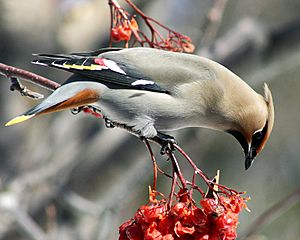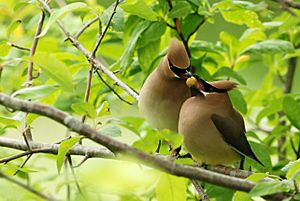Waxwing facts for kids
Quick facts for kids Waxwings |
|
|---|---|
 |
|
| Bohemian waxwing (Bombycilla garrulus) | |
| Scientific classification |
|
| Kingdom: | Animalia |
| Phylum: | Chordata |
| Class: | Aves |
| Order: | Passeriformes |
| Suborder: | Passeri |
| Family: | Bombycillidae Swainson, 1831 |
| Genus: | Bombycilla Vieillot, 1808 |
| Species | |
Waxwings are a group of three types of passerine birds. They are known for their soft, silky feathers. These birds are usually pinkish-brown and light grey. They have a cool crest on their heads and a black stripe across their eyes.
A special thing about waxwings is the red tips on some of their wing feathers. These tips look a lot like the red wax used to seal old letters. That's how they got their unique name! There are three main types of waxwings: the Bohemian waxwing, the Japanese waxwing, and the cedar waxwing.
Waxwings don't fly super long distances when they migrate. Instead, they move around a lot, especially when it's not breeding season. They mostly eat fruit. But if fruit isn't around, they'll eat tree sap, buds, flowers, and even insects. They often build their nests near water. Both parents help raise their young birds.
Contents
What are Waxwings?
Waxwings are known for their very soft and silky feathers. They have special red tips on some of their wing feathers. These tips are where the feather shafts go beyond the main part of the feather. For the Bohemian waxwing and cedar waxwing, these tips look like the red wax used for sealing letters. This is why they are called "waxwings."
These birds have short, strong legs and pointed wings. Both male and female waxwings look alike. They mostly have brown feathers. They also have a black line through their eye and black under their chin. Their tail is square-shaped with a red or yellow tip. Plus, they have a cool pointed crest on their head. Their beak, eyes, and feet are dark.
Adult waxwings change their feathers between August and November. Their calls are high-pitched, buzzing, or trilling sounds.
What Waxwings Eat
Waxwings are birds that live in trees. They make their homes in northern forests. Their main food is fruit. They eat different fruits depending on the time of year.
In early summer, they enjoy strawberries, mulberries, and serviceberries. Later in summer and fall, they eat raspberries, blackberries, cherries, and honeysuckle berries. In late fall and winter, they find juniper berries, grapes, crabapples, mountain-ash fruits, rose hips, and mistletoe berries.
They pick fruit while sitting on a branch. Sometimes, they even hover in the air to grab a berry! In spring, they switch to eating tree sap, buds, and flowers. During warmer months, they catch many insects. They find insects by looking through leaves or by catching them in mid-air. They often nest near water because there are lots of flying insects there.
How Waxwings Reproduce

Waxwings pick places to nest where there is plenty of fruit. They also breed later in the year to make the most of summer fruits. However, they might start looking for a mate as early as winter.
When a pair is courting, they do a special dance. They pass a fruit or a small object back and forth many times. Eventually, one of them will eat the fruit if it's edible. To make sure many birds can nest where there's good food, a pair doesn't protect a large area. This might be why waxwings don't have a true song. But a bird might chase away other birds to protect its mate.
Both male and female waxwings gather materials for the nest. But the female does most of the building. She usually builds a loose, big nest on a horizontal branch or in a fork of a branch. She keeps it far from the tree trunk. She uses twigs, grass, and lichen to build it. She then lines the nest with fine grass, moss, and pine needles. She might even decorate it with hanging pieces of grass, flowers, and moss to hide it. The female sits on the eggs to keep them warm. The male brings her food while she's on the nest. Once the eggs hatch, both parents feed the baby birds.
Waxwing Migration
Waxwings are not birds that fly very long distances for migration. Instead, they move around in an unpredictable way when it's not breeding season. They fly south from their summer homes in winter. If there aren't many berries in a certain year, huge numbers of waxwings might fly far beyond their usual areas. These groups can sometimes have thousands of birds!
Types of Waxwings
There are three main types of waxwings:
- Bohemian waxwing, B. garrulus (Linnaeus, 1758)
- Japanese waxwing, B. japonica (Siebold, 1824)
- Cedar waxwing, B. cedrorum Vieillot, 1808
Images for kids
-
Male Bohemian waxwing
See also
 In Spanish: Bombycilla para niños
In Spanish: Bombycilla para niños




